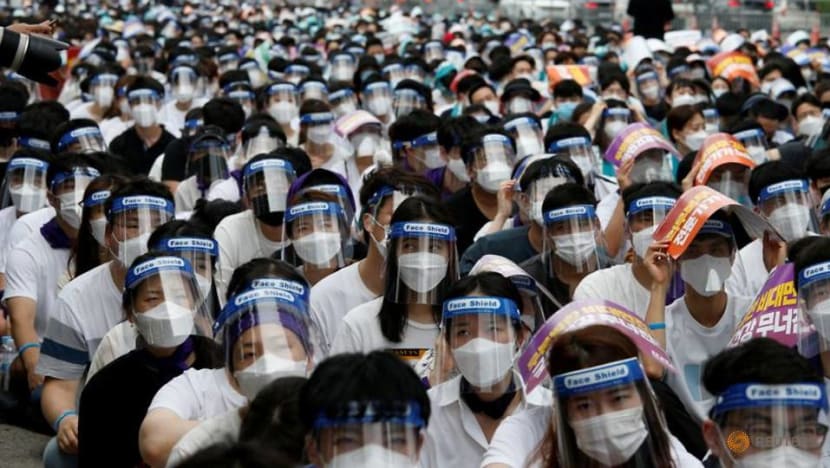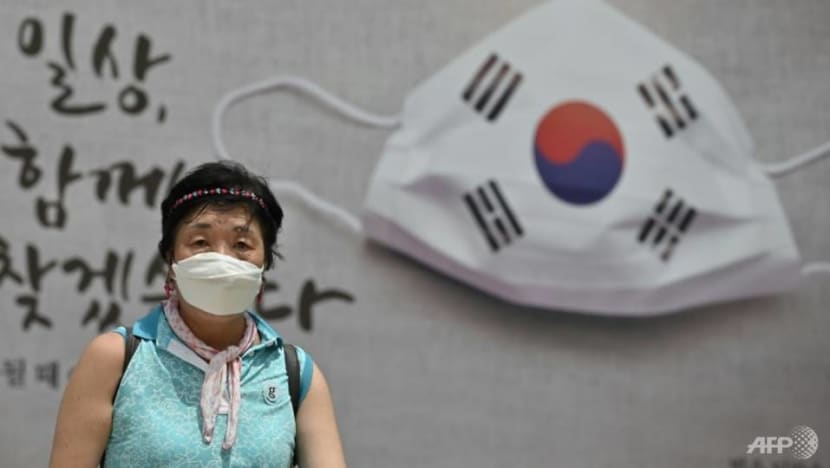commentary Commentary
Commentary: South Korea had COVID-19 under control. And then August happened
South Korea looked like it had COVID-19 under control but a freak series of events has picked at the seams of this divided society, says Steven Borowiec

Medical residents and doctors attend 24-hour strike amid COVID-19 pandemic in Seoul. (Photo: Reuters)
SEOUL: After South Korea successfully reined in a large outbreak of coronavirus cases in April, South Koreans participated in an online campaign expressing heartfelt appreciation for professionals who led the public health response.
Under the banner of Thanks To You, people across the country posted photos of themselves on social media conveying gratitude to healthcare professionals, making the Korean sign language for “pride” and “respect”.
Among notable luminaries who posted on Instagram were retired figure skater Yuna Kim and K-pop star BoA.
The campaign came at a time when South Korea revelled in praise from abroad. While countries in the West grappled with outbreaks spinning out of control, South Korea appeared to have beaten the virus without lockdown measures, and seemed poised to get back to life as, mostly, normal.
South Korea’s number of daily new coronavirus cases stayed below 50 for a while.
The Thanks To You campaign was meant to bestow a sense of recognition on South Korean healthcare workers who had toiled for long hours and risked their health to fulfill a sacred duty to keep the public safe.
READ: Commentary: South Korea will outperform many developed economies in this coronavirus downturn
READ: Commentary: Is North Korea tearing at the seams?
And yet, much has changed in the ensuing months, particularly in the past few weeks.
EVERYTHING CHANGED IN AUGUST
First, in mid-August, a frightening second wave of coronavirus spread burnt through in South Korea.
Over 1,000 infections have been tied to an anti-government rally led by Sarang Jeil Church, a religious group led by a pastor, Jung Kwang-hoon, with a history of vocal opposition to President Moon Jae-in.
Infections among participants, including Mr Jung, were reported and officials have been on alert over nationwide spread, as many had travelled to Seoul for the rally before returning home to places across the country.

The first outbreak in South Korea took place in February and March, and was mostly concentrated in the southern city of Daegu, away from the densely-populated Seoul area. Officials have warned repeatedly that this incident could outstrip that first wave in impact.
HEALTHCARE WORKERS LETTING THE COUNTRY DOWN
Alongside these jitters, many healthcare professionals, once feted as national heroes, have become targets of criticism.
Last week, doctors nationwide carried out a three-day strike to protest a government plan to increase the number of doctors in South Korea by 4,000 and open a new public medical school.
The Korean Medical Association said they will not fully end the strike until the government withdraws these planned policy changes, raising the spectre of disruptions to medical services at a critical time in the nation’s fight against the coronavirus.
LISTEN: The COVID-19 vaccine will be the biggest product launch in history. Can we pull it off?
READ: Commentary: Making a trip to the clinic is not the only way to get medical treatment during COVID-19
These doctors have argued that the government’s plan won’t solve South Korea’s problem of insufficient medical care in rural areas. They say the government should first work to improve conditions for doctors, by ensuring hospitals respect the legal limit on working hours for doctors and decreasing patient loads.
They are also concerned these fresh government regulations would drastically increase the supply of doctors and drive earnings down, while weakening their bargaining power.
The striking doctors have garnered accusations they are shirking duty when the country needs them most.
Their decision to walk out has been touted as a sign of South Korea’s heretofore cohesive response to the coronavirus fraying. “The Streets Are Screaming,” shouted the front-page headline of Monday’s national daily Hankook Ilbo newspaper.
Instead of being a pillar of strength aiding the country through this surge of infections, doctors are now seen as self-interested and even opportunistic.

Public opinion leans towards the argument that the doctors have a public duty and ought to return to work.
FATIGUE OVER MEASURES
The mood in the country is poor. Over the weekend, videos circulated around Korean-language Internet sites showing violent scuffles on the Seoul subway involving passengers who refused to wear masks.
Experts have attributed these skirmishes to pandemic fatigue. South Koreans were told at the start of 2020 to stay inside over the late winter and spring and that things would get better.
Now, as a humid late-summer heat wave begins to fade, and the crisp autumn weather approaches, the country has only tightened its social distancing rules, leaving a bad taste in people’s mouths.
READ: Commentary: Wear your mask properly! Uncovering the reasons behind public mask shaming
READ: Commentary: Philippines’ returning workers are heroes. Yet many are stranded, competing with countrymen for jobs in Manila
Many have lost their jobs. The real economy has been decimated, making it hard for many to stomach indefinite social distancing. Over 1.13 million people are unemployed – a two decades’ high.
FRUSTRATION OVER MIXED MESSAGING
South Koreans are frustrated at the government’s poor response to these events.
Moon’s administration had declared a one-time public holiday for Aug 17 and encouraged the public to go out and consume to revive the economy.
That now looks like unchecked optimism when an anti-government rally held on Aug 15 resulted in a spike in infections. In the wake of these cases, Moon has limited moral high ground to claim participants should have known better than to hold a gathering.
The government has also blamed the current outbreak on members of the right-wing Sarang Jeil Church and the church’s decision to hold a large outdoor gathering.

Critics countered by accusing the Moon administration of hypocrisy. After all, the government had approved an outdoor memorial in mid-July marking the death of Seoul Mayor Park Won-soon, a close political ally of Moon’s, that drew thousands, though no coronavirus infections were reported in connection.
A DEEPLY DIVIDED COUNTRY
These latest developments underscore how deeply divided South Korea has been, with politics a long, antagonistic tussle between two sides.
The country’s left wing, to which President Moon belongs, has long been at odds with the Christian right, with the two sides disagreeing on almost everything.
Moon and his ruling party currently enjoy a comfortable majority in the legislature, meaning buy-in from other parties isn’t necessary to pass policy changes. They have faced accusations of high-handed behaviour and a failure to engage stakeholders.
As one doctor explained to me in his Seoul office last week, it really bothered medical professionals that the government announced the policy changes without consulting the medical community.
That doctor also told me he thought the gratitude expressed in the Thanks To You campaign and in public addresses by politicians were empty, as they were not accompanied by measures to offset the costs doctors in private practice incurred in testing and treating coronavirus or overtime pay.
Throughout the pandemic, the South Korean public has judged the government’s response as mostly wise and followed guidelines. But the clumsy messaging on doctors, on COVID-19’s threat to public health and more from the top is splintering South Korean society.
To expedite an end to the standoff, Moon should invite doctors for a meeting to hear out their grievances, and pledge to work with them going forward.
That would be a first step to reconciling the growing divide in the country. It would also be a more meaningful way to say “thank you” for their efforts.
BOOKMARK THIS: Our comprehensive coverage of the coronavirus outbreak and its developments
Download our app or subscribe to our Telegram channel for the latest updates on the coronavirus outbreak: https://cna.asia/telegram
Steven Borowiec is the politics editor of Korea Expose.












